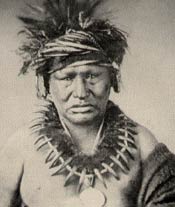Sauk Indian
(c 1780-1848)

Chief Keokuk (Kiyo`kaga, ‘one who moves about alert’ ) of the Sauk tribe in central North America was one of the men responsible for starting the Black Hawk War.
He was a member of the Fox clan, born on Rock river, Illinois. He was not a chief by birth, but rose to command through ability and force of character. At an early age he became a member of the Sauk council and later stepped into prominence as a tribal guest-keeper. His lodge soon became a center for all social and political affairs and Keokuk was able to use his office to further his own ambitions. He worked his will against custom in veiled, diplomatic ways, secretly playing one faction against another. In time he became the leading councilor in the Sauk assembly, and enjoyed great popularity among his people.
On July 15, 1830, U.S. Indian Comissioner William Clark signed a treaty with Saulk and Fox which ceded over 26-million acres of Sauk land east of the Mississippi to the government of the United States. It also created a neutral gound boundary between the Sauk and Foxes and their traditional enemies, the Sioux. The treaty was signed by Keokuk, and in November 1830 was approved by the Dakota Sioux. In the spring of 1830, when Black Hawk and his followers returned from their hunt, they found white settlers occupying their village. Black Hawk had not sanctioned the sale of this land and was determined to regain the village. This was the instigation of the 1832 Black Hawk war.
Those of the Sauk who favored a call to arms turned to Black Hawk who became their leader. Black Hawk was of the Thunder clan (Black-big-chest). Thus the political union between the Sauk and the Foxes was broken. The fighting began before Black Hawk was ready, and he was forced to charge with only a small number of those on whose support he had depended. With his depleted forces he could not successfully contend against the Illinois militia and their Indian allies.
Keokuk loomed up again during the final negotiations growing out of the war, and played so deftly into the hands of the Government officials that he was made chief of the Sauk, an action that aroused great anger and contempt by Black Hawk. When Keokuk became chief of the Sauk he was generally ridiculed by both Sauk and Foxes because he was not of the ruling clan. But there was one occasion in which he was honored. In the city of Washington, in debate with the representatives of the Sioux and other tribes before Government officials, he established the claim of the Sauk and Foxes to the territory comprised in what is now the state of Iowa. He based this claim primarily on conquest.
On his death from dysentery, in April 1848 in Kansas, where he had moved three years earlier, the chieftainship, with its unsavory associations, went to his son, Moses Keokuk (Wunagisäa, ‘he leaps up quickly from his lair’). Those who knew both father and son maintain that the son was superior in both intellect and ethics.
In 1883 the remains of the elder Keokuk were removed from Kansas to Keokuk, Iowa, where they were reinterred in the city park and a monument erected over his grave by the citizens of the town.





